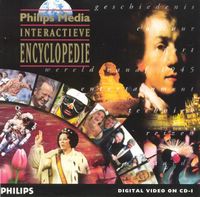The introduction of CD-ROM was a threat for online. CD-ROM was seen as a easy-to-handle and cheap replacement for online text bases. Besides it was an easy medium to price in comparison with online. Online prices consisted of various costs components such as telephone costs, modem speed costs, connect time and copyright, which made it difficult to calculate a search action.
But CD-ROM got a competitor. From the launch of CD-ROM one of the inventors of CD-ROM started in fact its competitor. Using the slogan that CD-ROM was for the professional for use on his computer, Philips started to develop a compact disc for use in combination with the television under the name CD-interactive (CD-i). By 1986 Philips officially announced the development of CD-i, but it took till 1991 before the product was commercially to be rolled out. On October 1, 1991 Jaap Timmer the CEO of Philips, launched CD-I in a New York disco; a year later CD-I was available in the Netherlands.
In the meantime the new media world had changed. Multimedia had also made its way in the PC world. In fact a first industry standard for PCs, MPC, was set. This stimulated the production of multimedia CD-ROMs and consumers did not see any reason to buy another player, even when Philips started to interest publishers for content (Philips called it software!).
The book and magazine publishers hardly reacted; Philips forgot that publishers do not own rights to movies and music. So, Philips decided to start its own publishing house Philips Media. The genres it published were ranging from documentaries like one of the first titles on China, opera performances from the bariton Pavarotti, movies like 21/2, reference works like an encyclopedia and games. In fact CD-i was covering the whole spectrum of entertainment and education. This yielded the new word combination edutainment. Yet CD-i did not become popular with the consumers at all. It was not a movie carrier; it was too slow for a gaming console; it was no hifi music box and it was no home movie center.

In 1996 Philips Media published an encyclopedia on CD-i and CD-ROM (collection Jak Boumans)
CD-i was contrary to CD-ROM no threat to online. But in the end CD-i was seen as a means to online. By 1996 Internet was successful and in order to push the medium, the combination of CD-i with a modem was developed as the CD-i Online service and the CD-i Club. But it was no use anylonger to whip a dead horse. In 1997 the new CEO of Philips Cor Boonstra decided to kill off the consumer CD-i activities. The hardware development was stopped and the titles sold to the French company Infogrames.


CD-i was promoted as a gift during the Promotion Week for Books (left), but it was also used for the distribution of light amusement (right). Collection Jak Boumans
CD-i was never a real product and it was certainly no product to combine with online. Eventually CD-i came full circle with the introduction of DVD. One benefit of the CD-i period has been the early acquaintance of the Dutch new media production companies with multimedia. Contrary to videotex companies the multimedia production companies such as CODIM/ISM, Explainer DC, Lost Boys, NOB Interactive/Bright Alley en Valkieser moved seamlessly into the Internet era.
(Promotion videos of CD-i discs can still be viewed on the site of the International New CD-i Association)

No comments:
Post a Comment